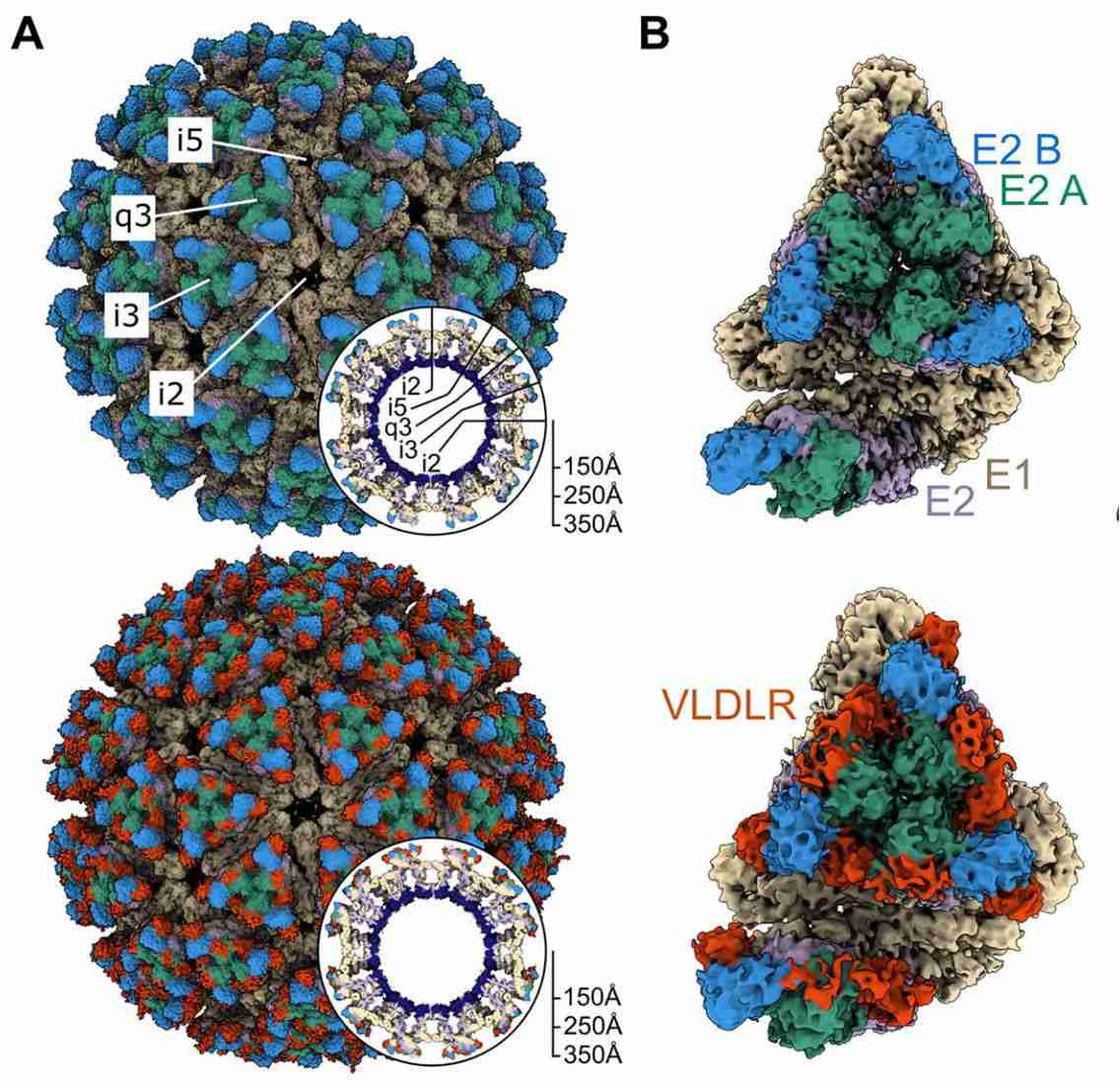Structural Research of Togaviridae
The Togaviridae are a group of small enveloped viruses with single-stranded positive-stranded RNA genomes, including the genera Alphavirus and Rubivirus. Most alphaviruses are transmitted by mosquitoes and are pathogenic to vertebrate hosts. Rubavirus, the only member of Rubivirus, is the causative agent of rubella (German measles) in children and can cause birth defects in early pregnancy in the form of congenital rubella syndrome. Arthropod-borne viruses of the Togaviridae family have caused major public health problems and resulted in worldwide epidemics. To better understand the mechanisms of infestation of these viruses, scientists have used advanced microscopic techniques to resolve their complex structures, which are essential for the development of antiviral drugs and vaccines.
 Figure 1. Mechanism for broad recognition of alphaviruses. (Sutton MS, et al, 2023)
Figure 1. Mechanism for broad recognition of alphaviruses. (Sutton MS, et al, 2023)
Structural Features of Togaviruses
Togaviruses possess several distinctive structural features. They have enveloped viruses with a robust icosahedral capsid consisting of 240 copies of the nucleocapsid protein. Within the envelope, 80 trimer spikes include the E1 and E2 glycoproteins. The RNA genome of Togaviruses ranges from 9.7 to 11.8 kb and is both capped and polyadenylated. The viral infection process involves the attachment of the viral E glycoprotein to host receptors, which triggers clathrin-mediated endocytosis, allowing the virus to enter the host cell. Subsequently, the virus membrane fuses with the host endosome, releasing the RNA genome into the cytoplasm. The positive-sense single-stranded RNA is then translated into a polyprotein. This polyprotein is cleaved by the viral nsP2 protease, producing non-structural proteins that play a vital role in RNA replication and transcription. Additionally, the positive-sense single-stranded RNA is transcribed into a complementary antisense RNA, which serves as a template for the synthesis of genomic single-stranded RNA.
Progress in Structural Research on Togaviridae
Eastern equine encephalitis virus (EEEV) belongs to the New World alphaviruses and is the most pathogenic of the encephalitis alphaviruses. There are no approved countermeasures for EEEV infection. Research has found that the very low-density lipoprotein receptor (VLDLR) consists of eight LDLR type A (LA) structural domains that support EEEV entry. Researchers achieved resolutions of 3.78 Å and 4.75 Å with icosahedral symmetry by resolving multiple cryo-electron microscopy structures of the EEEV-VLDLR complex and performing mutagenesis and functional research. informing the design of the smallest VLDLR decoy receptor, which neutralizes EEEV infection. Like previous alphaviruses, the EEEV VLP exhibits T = 4 icosahedral symmetries with 80 trimeric spikes composed of E1/E2 heterodimers.
 Figure 2. Cryo-EM structure of EEEV PE–6 in complex with VLDLR. (Adams LJ, et al, 2024)
Figure 2. Cryo-EM structure of EEEV PE–6 in complex with VLDLR. (Adams LJ, et al, 2024)
Virus-like particles (VLP) have evolved into a major method for researching the structure of viruses and play an essential role in the field of vaccinology. As a leading biomolecule structure analysis company, Creative Biostructure offers a comprehensive range of virus-like particles (VLPs) products for a variety of applications, helping researchers advance virology-related research, such as viral infection, diagnostics, vaccine discovery, and antiviral drug development.
| Cat No. | Product Name | Virus Name | Source | Composition |
| CBS-V065 | Chikungunya Virus VLP (E1, E2, C Proteins) | Chikungunya virus | Mammalian cell recombinant | E1, E2, and capsid (C) protein |
| CBS-V560 | CHIKV VLP (E1; E2 Proteins) | Chikungunya virus | Mammalian cell recombinant | E1; E2 |
| CBS-V928 | Mayaro Virus VLP (E1; E2; Capsid) | Mayaro virus | HEK293 | E1; E2; Capsid |
| Explore All Togaviridae Virus-like Particle Products | ||||
Utilizing cutting-edge cryo-electron microscopy (cryo-EM) technology sets Creative Biostructure apart in the field of structural analysis. We pride ourselves on providing comprehensive and accurate viral structure analysis services that enable researchers and pharmaceutical companies to improve their understanding of viruses, develop targeted interventions, and make significant advances in the fields of virology, vaccine development, and antiviral therapy. Please contact us for a formal quote.
References
- Sutton MS, et al. Vaccine elicitation and structural basis for antibody protection against alphaviruses. Cell. 2023. 186(12): 2672-2689.e25.
- Adams LJ, et al. Structural and functional basis of VLDLR usage by Eastern equine encephalitis virus. Cell. 2024. 187(2): 360-374.e19.
- Chen R, et al. ICTV Virus Taxonomy Profile: Togaviridae. J Gen Virol. 2018. 99(6): 761-762.